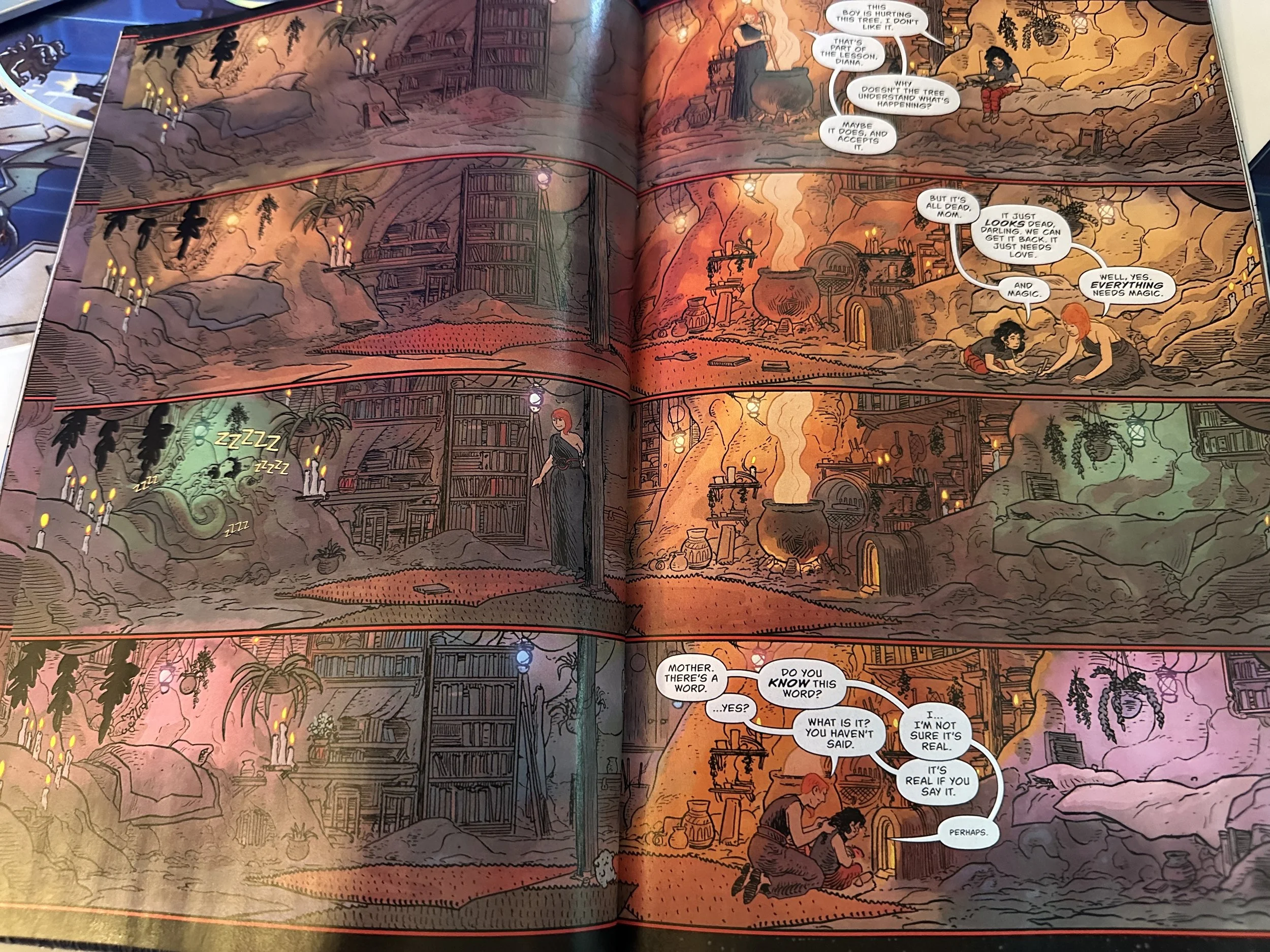Absolute Wonder Woman #1 [Review]
As part of DC’s high-stakes All-In campaign, Absolute Wonder Woman #1 by Kelly Thompson, with art by Hayden Sherman, colors by Jordie Bellaire, and lettering by Becca Carey, is an audacious new beginning for Diana Prince AKA Wonder Woman. Following the groundbreaking success of Absolute Batman, DC’s latest relaunch focuses on an entirely reimagined Wonder Woman, steering the character into unfamiliar and daring territory. Here, Diana’s origin is reshaped not in the light of Themyscira’s paradisiacal shores, but in a harsher, otherworldly realm. Raised by Circe, Diana is not merely the Amazonian princess we know and love but is redefined as the “Princess of Hell” and “Witch of the Wild Isle” - this layered, mythic recontextualization serves as a bold entry into a Wonder Woman mythos with immense potential.
The story opens with a harrowing image of Diana battling a swarm of flying beasts off the coast of California—a fierce introduction that sets the tone for the rest of the issue. We quickly segue into her revised backstory, crafted under the nuanced pen of Thompson, who places her origin on an island far removed from the idylls of Themyscira. Abandoned as an infant on an island of Hell and bound by a divine curse, young Diana is bereft of her Amazon identity, with the very word itself magically erased from Circe’s lexicon, though the spell seemed to have a lesser impact on Diana directly. Under the reluctant, evolving guardianship of Circe, Diana is raised not by warriors, but by a sorceress of formidable renown. As she grows, her skills—especially in magic—are honed under Circe’s tutelage, her powers and identity sculpted by a past both tragic and profound.
Thompson’s writing is the backbone of this tale, bringing together intensity, emotional weight, and grandeur in ways that make Absolute Wonder Woman #1 stand out. From the poetic cadence of Diana’s dialogue to the fierce declarations of protection and power, Thompson infuses Diana with a blend of tenderness and tenacity. Diana is depicted as a warrior who embodies both her Amazonian heritage and her own unique path—one that carries the potent influence of her “mother” figure, Circe. By weaving themes of legacy, isolation, and inner strength, Thompson reframes Diana’s mission not just as a fight for justice but as a deeply personal journey. The writer’s sensitivity to Diana’s dualities shines especially in the tender, if strained, exchanges between Circe and Diana. Their relationship is complex, a blend of mentorship, love, and resentment, and through it, Thompson draws readers into Diana’s struggle with her origins, her sense of duty, and her own identity.
Sherman’s artwork elevates this origin story with a gritty, visceral style that serves as a stunning contrast to Thompson’s lyrical prose. His technique, with bold outlines and textured details, pulls readers into a world that feels both ancient and intensely real. There’s a raw, almost tactile quality to Sherman’s line work that emphasizes the weight of the battles Diana faces—not just with monstrous creatures but with the past she carries. The color palette, courtesy of Bellaire, complements this aesthetic perfectly. Fiery reds and dark earth tones permeate the panels, especially during scenes of confrontation, giving the issue a mythic, dangerous atmosphere that suits Diana’s intense debut.
Sherman’s portrayal of Diana strikes a balance between fierce authority and ethereal grace. Her stances and expressions reflect not only her physical strength but also a sense of otherworldly purpose. In battle, she is unstoppable; in moments of reflection, there’s a softness, a vulnerability, that belies her hardened exterior. The cavern scenes with Circe, softened by muted hues and thoughtful lighting, show Sherman’s skill at capturing both grandeur and intimacy. These scenes are tinged with a lived-in realism, lending a palpable authenticity to Diana’s mystical upbringing. Sherman’s ability to ground these fantastical elements in a world that feels simultaneously foreign and familiar makes the reading experience all the more immersive.
The collaborative synergy between Thompson and Sherman ensures that this issue reads as more than just an origin story; it’s an epic that connects Diana’s mythic past with her present-day mission. Letterer Becca Carey deserves special mention for the way her lettering flows through the pages, capturing the emotional intensity and rhythm of Thompson’s writing without interrupting the visual narrative. Together, this creative team delivers a cohesive and powerful rendition of Diana Prince, one that feels equally inspired by the past and completely new.
Absolute Wonder Woman #1 is a striking entry into the All-In series that embraces the core of Wonder Woman’s character while offering something genuinely fresh and imaginative. The story’s mythic depth, combined with dynamic visuals, sets it apart as a unique take on Diana. In this iteration, Wonder Woman is not simply a warrior or a princess—she’s a figure born of darkness and fire, taught by sorcery as much as compassion. For both longtime fans and newcomers alike, this is a story that brings new layers to a legendary character and opens up exciting possibilities for her journey ahead.
Thompson and Sherman have laid a strong foundation for what could be one of the most intriguing explorations of Wonder Woman to date. This reimagined Diana is fierce, driven, and undeniably epic—a heroine whose origin is as awe-inspiring as her mission. Absolute Wonder Woman #1 is not just a comic; it’s a bold chapter in the history of an icon, inviting us to witness the rise of a Wonder Woman who is as complex as she is powerful.



